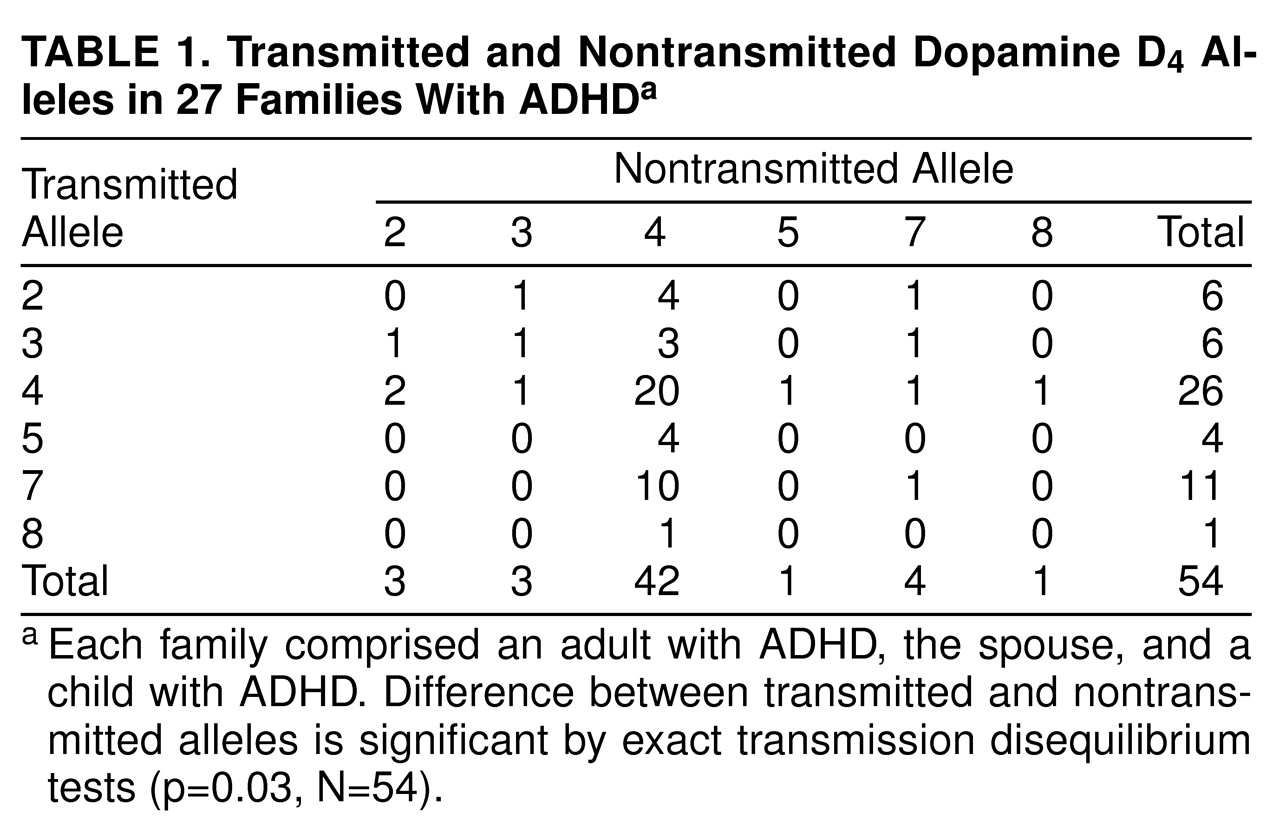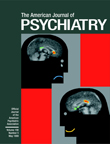It is now well established that the biological relatives of children with attention deficit hyperactivity disorder (ADHD) are at increased risk for ADHD and other psychiatric disorders
(1). Additional lines of evidence from twin, adoption, and segregation analysis studies suggest that the familial aggregation of ADHD has a substantial genetic component
(1).
There have been few molecular genetic studies of ADHD. These have relied on either case-control or family-based association studies. Both studies capitalize on linkage disequilibrium, the fact that very small stretches of DNA will tend to be transmitted together through the generations. This means that if a DNA marker is either within a disease gene or very close to it, one version of that marker will be more common among diseased subjects, even if the marker itself has no functional significance. Case-control studies can produce spurious associations if the case and control groups are not well matched for ethnicity. In contrast, because family-based studies use parental alleles as a “control group,” this confounding does not occur.
Conflicting data have emerged from studies of the dopamine D
4 (DRD4) gene in ADHD. Ebstein et al.
(2) reported a case-control study in which the 7-repeat allele of DRD4 was associated with novelty-seeking. People with high levels of this personality trait are impulsive, exploratory, excitable, and quick-tempered—well-known features of ADHD. The association between DRD4 and novelty-seeking was replicated in a study that combined both case-control and family-based measures
(3) but not in other case-control studies
(4–
7).
LaHoste et al.
(8) noted several reasons why the DRD4 7-repeat allele has functional implications that are relevant for ADHD. This variant of DRD4 mediates a blunted response to dopamine. Moreover, the distribution of DRD4 mRNA in the brain suggests that it plays a role in cognitive and emotional functioning. LaHoste et al. found higher rates of the 7-repeat allele among ADHD children than among control children. This rate was maintained when the sample was increased by 50%
(9).
The same group reported a trend association between the 7-repeat allele and ADHD in a small (N=19) family-based association study and a significant association in a case-control study of ADHD adults
(10). Two family-based studies
(11,
12) found excess transmission of the 7-repeat allele to ADHD children, but in one of these studies
(11), this was limited to families where no other relative had ADHD. Moreover, a case-control study failed to replicate the ADHD-DRD4 association
(13).
The present study sought to assess the association between ADHD and DRD4 in a group of families ascertained through a clinically referred ADHD adult. We used this strategy because the two available family studies of adult ADHD suggest that it is a highly familial disorder
(14,
15).
METHOD
The families reported in this study were spouses and ADHD children of 27 ADHD adult patients from our psychopharmacology clinic (one spouse was also found to have ADHD). These adults had received a clinical diagnosis of ADHD and met DSM-IV criteria for ADHD when evaluated with the ADHD module from the Schedule for Affective Disorders and Schizophrenia for School-Age Children—Epidemiologic Version
(16), modified to assess DSM-IV criteria. The spouses and children were similarly evaluated, and all family members provided blood for subsequent DNA extraction. The parents provided written informed consent for themselves and their minor children, who also provided oral assent.
DNA strands were isolated from whole blood as described by Schumm et al.
(17). The DRD4 gene contains a varying number of 48 base pair repeats within the gene. We used a method described by Lichter et al.
(18) and modified it by adding 7-deazaglutamyl transpeptidase (0.2 mM final concentration) and 10% dimethyl sulfoxide to the polymerase chain reaction cocktail. The polymerase chain reaction products were separated by electrophoresis on 3.5% NuSieve (FMC Bioproducts, Rockland, Me.) and stained with ethidium bromide. Laboratory procedures were blind to the diagnoses of subjects.
We analyzed the data with the exact multiallele transmission disequilibrium test of Cleves et al.
(19), as implemented in the program SYMMETRY. Because this is an exact test, it is accurate when cell sizes are small or even zero. To determine which alleles accounted for the significant result, we computed a chi-square statistic contrasting the cell numbers for each pair of nondiagonal cells in the transmission disequilibrium test table. Because we had an a priori reason to suspect that the 7-repeat allele would account for the association between ADHD and DRD4, we did a confirmatory assessment of the role of the 7-repeat allele by assessing the chi-square contribution of each of the five pairs of cells in which the 7-repeat allele was transmitted and another allele was not (and vice versa). For these analyses, we used a Bonferroni-corrected p value of 0.01.
We used logistic regression to determine if, among family members, the number of 7-repeat alleles predicted the diagnosis of ADHD. Because the nonindependence of siblings from the same family leads to inaccurate estimates of statistical significance, we adjusted our analyses by using Huber’s formula
(20) as implemented in the Stata Reference Manual
(21) to produce accurate statistical tests.
RESULTS
Each parent in the 27 families has two DRD4 alleles; one is transmitted to the ADHD child, the other is not.
Table 1 shows the 54 pairs of transmitted and nontransmitted alleles. The exact multiallelic transmission disequilibrium test for the table was significant (p=0.03, N=54), indicating that one or more alleles were preferentially transmitted to the ADHD child.
The follow-up chi-square tests of cells containing the 7-repeat allele found that only one pair significantly contributed to the overall significance: the number of times the 7-repeat allele was transmitted and the 4-repeat allele was not (N=10) was greater than the number of times the 4-repeat allele was transmitted and the 7-repeat allele was not (χ2=7.4, df=1, N=1, p=0.007). This met our Bonferroni criterion for statistical significance (0.01). No other pair of cells even approached statistical significance (all chi-square values ≥2, df=1, all p values ≥0.39).
Consistent with the transmission disequilibrium test results, logistic regression showed that the number of 7-repeat alleles was a significant predictor of the diagnosis of ADHD among family members (z=2.5, N=81, p=0.01). The probability of having ADHD among subjects with zero, one, and two 7-repeat alleles was 0.58, 0.73, and 1.00, respectively.
DISCUSSION
Our results suggest that there may be an association between ADHD and the 7-repeat allele of the dopamine D
4 gene in families ascertained through ADHD adults. The DRD4 results are encouraging because positive associations with the 7-repeat allele have been reported from ADHD samples
(8–
11). Notably, the prevalence of the 7-repeat allele is low in Asian populations
(22), as is the prevalence of ADHD
(23).
Although we view our results as suggestive, especially in light of prior work, several considerations call for caution in declaring DRD4 to be an ADHD gene. Only 13 of the parents provided information about the transmission of the 7-repeat allele. A larger group would be needed to draw definitive inferences. There has been one failure to replicate the DRD4 association in a case-controlled study
(13), and our finding of a positive association in nuclear families containing an ADHD child and an ADHD adult conflicts with the report by Bailey et al.
(11) that the association was limited to families in which no other relative had ADHD. Even if the DRD4-ADHD association is real, it could be caused by an unknown gene very close to DRD4.
Notably, 58% of subjects without the 7-repeat allele had ADHD. This prevalence is higher than one would expect in the population, given that our method of ascertainment called for both an ADHD parent and an ADHD child. Nevertheless, it suggests that the 7-repeat allele cannot be viewed as a necessary cause of ADHD. These challenges to a DRD4 hypothesis for ADHD call for further work to clarify the relevance of the association that we have reported.


